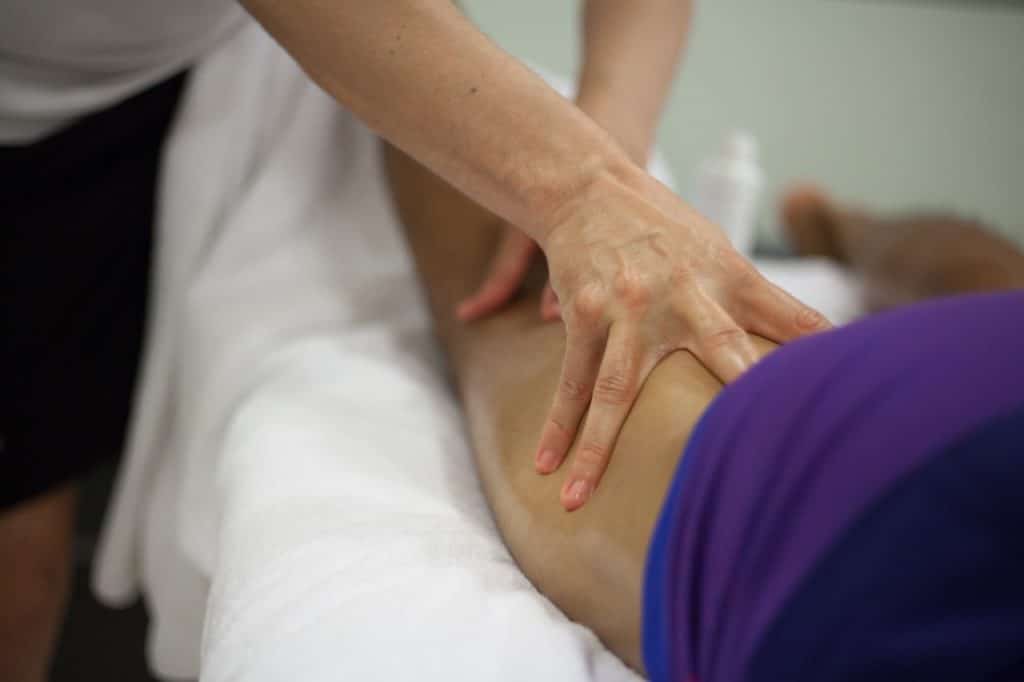Introduction to myofascial release therapy
Myofascial release therapy is a manual therapy technique used by physiotherapists to relieve pain and tension stemming from tight fascia and myofascial tissues. Fascia is an important connective tissue that surrounds and supports muscles, bones, and nerves throughout the body. Fascia tissue acts as a protective layer, and when it becomes tight or restricted, it can limit movement and cause discomfort. By applying gentle pressure and targeted stretching, this therapy helps release knots, ease tension in connective tissues, and restore mobility. It is particularly effective in improving movement, alleviating muscle and joint restrictions, and reducing widespread pain.
Sometimes, pain and movement issues are caused by fascia restrictions—areas of limited mobility that develop due to injury, overuse, or scar tissue. These restrictions can harden and tighten the fascia, leading to discomfort and restricted movement.
This therapy is beneficial for various conditions, including:
- Chronic pain: Myofascial release can provide relief for chronic pain conditions such as fibromyalgia, osteoarthritis, and migraines.
- Repetitive strain injuries: For those who work in jobs that involve repetitive movements, myofascial release can help prevent and alleviate pain associated with conditions such as carpal tunnel syndrome or tennis elbow.
- Sports injuries: Athletes often use myofascial release therapy to treat and prevent sports-related injuries by targeting tight areas in the muscles and connective tissues.
- Post-surgical recovery: Myofascial release can aid in post-operative healing by reducing scar tissue formation, helping to improve range of motion, and decreasing pain.
- Poor posture: Myofascial release can address imbalances and restrictions in the body caused by poor posture, helping to improve overall alignment and reduce discomfort.
Myofascial release also boosts blood flow and increases tissue temperature, promoting relaxation and relieving muscle tension. Key benefits include decreased tension in fascia and muscles, as well as improved circulation, which support healing and enhance mobility.

Understanding myofascial tissue
Myofascial tissue is a specialised type of connective tissue that surrounds and supports muscles, bones, and nerves. This fascia forms a continuous network throughout the body, linking various structures and playing a key role in pain management and movement. When myofascial tissue becomes restricted—due to injury, overuse, or prolonged inactivity—it can result in pain, tension, and limited mobility. Since the fascia network is integral to maintaining proper function and movement, any restrictions within it can trigger widespread discomfort. Myofascial release therapy aims to alleviate tension within this system, restoring mobility and reducing pain to support overall well-being.
Understanding myofascial pain
Myofascial pain is a common yet often misunderstood condition that affects the myofascial tissues—the important connective tissues that surround and support the muscles throughout the entire body. This type of pain can develop as a result of trauma, injury, repetitive strain, or underlying musculoskeletal conditions. When the myofascial tissues become tight or develop trigger points, it can lead to persistent discomfort, stiffness, and even restricted movement.
One of the most challenging forms of this condition is myofascial pain syndrome, which is characterised by chronic pain and tenderness in the myofascial tissues. This syndrome can significantly impact daily activities and overall quality of life, making effective pain management essential. Myofascial release therapy is a proven treatment option for managing myofascial pain. By applying gentle pressure to the affected areas, myofascial release treatment helps to release tension, restore normal function, and reduce pain throughout the body. This hands-on therapy targets the root cause of discomfort in the connective tissues, offering relief and supporting long-term recovery.
Benefits of myofascial release
Myofascial release offers numerous benefits, including reduced pain, pain relief, reduced fascia tension, and improved mobility. This therapy helps to break down scar tissue and adhesions; as a soft tissue treatment, it helps relieve tension and restore movement, enhancing soft tissue flexibility and function. By alleviating muscle tightness, relieving tightness, increasing overall movement efficiency, and promoting increased movement, myofascial release promotes better physical performance and recovery.
The treatment also enhances blood flow and raises tissue temperature—myofascial release increases temperature to promote healing, helping to ease pain and reduce inflammation.
By addressing restrictions that restrict movement, myofascial release enables more movement and flexibility. Commonly used to address conditions like carpal tunnel syndrome, myofascial release can be a valuable complement to physical therapy, supporting a holistic approach to healing and wellness.
Myofascial release technique
Direct myofascial release is a specialised technique used by physiotherapists to restore normal function by applying sustained pressure to elongate and soften the fascia. Myofascial release focuses on releasing restrictions in the fascia to improve mobility and alleviate pain. Similarly, soft tissue massage focuses on connective tissues and targets muscle tissues and soft tissues to alleviate discomfort and improve mobility.
Myofascial release combines gentle pressure and stretching to target knots and ease tension within the fascia, offering relief and enhanced flexibility. This technique can be applied to various areas of the body, including painful areas and stiff areas such as the back, neck, and legs. By releasing tension in the fascial system, myofascial release helps reduce pain and improve overall movement.
Self-myofascial release: Techniques you can try at home
Self-myofascial release is an accessible way to manage tension in your myofascial tissues from the comfort of your own home. One of the most popular tools for self-myofascial release is the foam roller, which allows you to apply pressure to specific areas of your body to help release tension and improve flexibility. By slowly rolling over tight or sore spots, you can encourage the myofascial tissues to relax and restore normal movement.
In addition to foam rolling, movement myofascial release techniques—such as gentle stretching and controlled body movements—can help target areas of tension. Myofascial release stretches are designed to lengthen and loosen the connective tissues, further supporting flexibility and comfort. While self-myofascial release can be highly effective, it’s important to consult with a massage therapist or healthcare professional before starting a new routine. They can provide guidance on proper technique and help you avoid injury, ensuring you get the most benefit from your self-care efforts.
Trigger point therapy
Trigger point therapy focuses on relieving stiff, knot-like areas in the fascial tissue known as trigger points. These points can cause localised or widespread pain and often limit muscle and joint movement. To address this, myofascial release therapy is commonly used, applying gentle pressure and stretching techniques to release knots and ease tension in the connective tissues. This form of therapy not only reduces pain but also improves mobility. Trigger point therapy is often combined with other treatments, such as physical therapy and massage, to enhance its effectiveness and provide comprehensive relief.
Health conditions helped by myofascial release
Myofascial release therapy has been shown to provide significant benefits for a wide range of health conditions. Individuals suffering from chronic pain, fibromyalgia, carpal tunnel syndrome, and other musculoskeletal conditions often experience relief through targeted myofascial release treatment. By reducing muscle tension and improving joint movement, this therapy can also be helpful for those dealing with nerve damage or overuse injuries.
Research, including systematic reviews and randomised controlled trials, supports the effectiveness of myofascial release in reducing pain and improving function for many patients. Improved blood circulation and decreased inflammation are additional benefits, making myofascial release a valuable option for managing chronic low back pain and other persistent issues. Physical therapy and occupational therapy programmes frequently incorporate myofascial release techniques to enhance recovery and restore normal function. Whether you’re dealing with acute discomfort or long-term health conditions, myofascial release therapy offers a holistic approach to pain management and improved well-being.
Myofascial release therapy at Waverley Clinic
At Waverley Clinic, we offer myofascial release therapy as part of our comprehensive range of services to improve your overall well-being. James Leyland, our expert physiotherapist, brings a wealth of skill and experience to every treatment. Specialising in myofascial release and movement therapies, he adopts a holistic approach to enhance mobility and relieve pain. With precision and care, James tailors each treatment to suit your individual needs, ensuring the highest level of personalised care.

Our myofascial release therapy sessions begin with a one-on-one consultation with James. During this time, he will carefully assess your condition and address any concerns you may have. This initial assessment helps him to create a personalised treatment plan tailored specifically for you.
During your session, our physiotherapist James will skillfully apply gentle pressure and stretching to specific areas of your body using his hands, elbows, or specialised tools. Myofascial release can be used to treat specific areas, such as the palmar fascia. To further enhance the treatment’s effectiveness, he may also integrate guided movements and breathing techniques.
As with any massage therapy, you may experience some discomfort or tenderness during the session. This is completely normal and should subside within a day or two. You may also feel an immediate relief of your symptoms, but it’s important to continue with the recommended treatment plan for long-term results.
Myofascial release can benefit a wide range of conditions, including chronic pain, sports injuries, postural problems, and overuse injury.
After your session, James will provide you with self-care tips and exercises that you can do at home to help maintain your progress. He may also recommend follow-up sessions depending on your individual needs and goals.
Why wait? Schedule your appointment with James today! Booking is now easier than ever:
Book online: Click here to book
Call us: Reach out to Waverley Clinic at 01252 716611
We offer a convenient 24/7 telephone appointment booking service, available seven days a week.
Say goodbye to pain and stiffness: Book a myofascial release therapy session with James at Waverley Clinic today!
Myofascial release is a gentle, hands-on therapy that uses sustained pressure to release fascial adhesions, alleviate pain, and improve mobility. This technique is often applied for injury recovery, scar tissue breakdown, and overall relaxation as part of therapy treatments.
Myofascial release therapy is a unique and effective hands-on technique that targets the fascia, a connective tissue that wraps around and supports all muscles, bones, nerves and organs in our body. When this tissue becomes restricted or tight due to injury, overuse or poor posture, it can cause pain, stiffness and limited range of motion.
In a myofascial release therapy session with James at Waverley Clinic, you can expect gentle, sustained pressure on specific areas of your body to release tension and restore mobility.
Myofascial release therapy can benefit anyone looking to improve their overall physical well-being. It is a gentle yet effective treatment that can be used alone or in conjunction with other therapies to address a wide range of issues.
Why wait any longer? Schedule an appointment with our skilled physiotherapist, James, and discover the incredible benefits that myofascial release therapy can bring to your well-being.
Booking is easy:
Book online now: Book Online
Call us directly: 01252 716611
Our seven-day, 24-hour telephone booking service ensures you can secure your appointment at your convenience.
Don’t miss out – book today!

